Features
Two murders of two Jewish Winnipeggers – one in 1913 and one in 1928 Could they have been eerily connected?
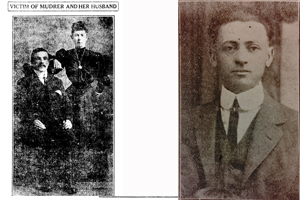
By BERNIE BELLAN The story you’re about to read started off in one direction – then, following a phone call I received Tuesday evening, January 25, took a completely different – and frighteningly eerie direction.
My original story was going to be about a new book that is about to be launched titled “The End of Her”. The book’s author, Wayne Hoffman, is someone who first came to my attention, and subsequently the attention of our readers, in 2015 when he sent me a tantalizingly provocative email whose subject was the long-ago murder of his great-grandmother, Sarah Feinstein.
Mrs. Feinstein was only 26 years old at the time of her murder and, although as Wayne Hoffman notes in his book, there have been many theories advanced as to who could possibly have wanted to murder such a young, innocent woman, the case remains a total mystery.
(You can read my story about “The End of Her” elsehwhere on this website.)
Now, the story of how Wayne Hoffman came to write his book is in of itself quite a fascinating one, but that January 25 phone call really sent my head spinning.
The caller, as it turned out, was a woman with a relatively deep voice. She began by saying that it had just been brought to her attention that there is a Jewish newspaper in Winnipeg. Not only had she never heard of The Jewish Post & News, she said, she wondered what any Jewish newspaper would be all about? Would it be religious in content? she asked. When I assured her that this paper is mostly secular in content she seemed more interested in perhaps taking out a subscription.
We were enjoying a lengthy conversation when the caller sprung this one on me – totally out of the blue: Her grandfather, whose name was Robert Cohen, she told me, had been murdered in Winnipeg in 1928.
“Really?” I asked. “That’s an amazing coincidence,” I said. I explained that I was going to be publishing a story about a new book whose subject was also a long-ago murder of a Jewish Winnipegger.
“I actually have a copy of his obituary,” the caller continued. “But it’s in Yiddish – and I can’t read it.”
She wondered in which newspaper it might have appeared. I said that the main Yiddish language circulation newspaper in Winnipeg at that time was something called Der Yiddishe Vort. I told the caller that I was going to try and see whether there was anything I could find out about her grandfather’s murder and that I would get back to her.
The next day I contacted Stan Carbone, curator of the Jewish Heritage Centre, and asked him whether he or Andrew Morrison, the Centre’s archivist, could help me find the obituary of Robert Cohen from 1928.
Andrew was quick to respond, writing me that when he did a search he was able to come up with one reference to a Robert Cohen in a February 27, 1928 edition of the Israelite Press (which was called Der Yiddishe Vort in Yiddish.)
Andrew sent me the link to the story, which I was able to access on the Jewish Heritage Centre website. What I found was a pdf of the front page from that February 1928 issue which had a story about someone named “Ruven Cohen”, not Robert Cohen. (I can read Yiddish somewhat but my understanding is quite limited.)
But, it was a front page story in that pdf – not an obituary. I realized immediately that the story was about Cohen’s murder.
Next, I contacted Rochelle Zucker, host of the Jewish Radio Hour, and asked her whether she might be able to translate the story for me. Rochelle obliged me that same evening.
Here is the shocking translation of that story , as provided by Rochelle Zucker:
Feb. 17, 1928 Israelite Press
Young Jewish Man from Winnipeg Mysteriously Murdered
R. Cohen murdered in the area of Shell Lake Sask.
Shelbrook Sask, – From the coroner’s inquest of the mysterious death of Ruven Cohen, a cattle merchant from Winnipeg it was found that the $1190 that he had with him when he was leaving the area remained in his pocket. Therefore, the motive for the murder could not have been robbery. The tragic death of R. Cohen, a young man from Winnipeg, made a deep impression here in the city. His body is expected to arrive tomorrow.
According to the information that has been received to date, Mr. Cohen, on his buying trip, had found merchandise in the area and had telegraphed to Winnipeg for money. He got the money and according to reports from the town of Kenwood in that area, he deposited $2000 in the bank. Monday, he took out $1200 and took it with him to pay the farmers for the animals that he bought.
He borrowed a horse from Alfred Schwartz, a Jewish farmer from the area, and rode on horseback in the area. Tuesday, the horse came back home with Cohen’s dead body on it. His hands and feet were tied to the saddle.
Mr. Schwartz and Harry Adelman, a merchant from Shell Lake, traveled immediately to Shelbrook, 40 miles from there and notified the police who immediately started an investigation.
The deceased left behind a widow and 4 children.
Wow! I thought – Mr. Cohen was murdered, but apparently he was not robbed – even though he was carrying a huge amount of cash on his person! And he was in Saskatchewan buying cattle! Sarah Feinstein’s husband, David, was also a cattle buyer who was in Canora, Saskatchewan at the time of her death.
How similar though was Ruven Cohen’s murder to Sarah Feinstein’s I asked myself. Here were two Jewish Winnipeggers, both murdered in the early part of the 20th century, yet with no apparent motive for either one’s murder.
Yet, there was much more to the story, as I was to find out. The next day I contacted the woman who had called me Tuesday evening to tell her what I had found out, including that her “grandfather” was murdered in Saskatchewan, not Winnipeg. But then I was in for another surprise when the woman with whom I was talking told me that she was 19 years old.
“Nineteen?” I said. “But you sound so much older.” After I got over how young this woman was it dawned on me that something else didn’t make sense.
Robert or Ruven Cohen – as he was referred to in the Israelite Press, couldn’t have been her grandfather. She’s much too young to have had a grandfather who was murdered as long ago as 1928. “He had to be your great-grandfather,” I said to her.
“I guess,” she answered. “I hadn’t really thought about it much.” I told her that I was so caught up in this story now that I was determined to try and find out whether there was anything else that I could find out about Mr. Cohen’s murder.
Subsequently, I renewed my subscription to something called newspaperarchives.com, which is a fabulous source for investigative reporters. I had actually taken out a subscription to that service a year and a half ago when I was pursuing the mystery of why someone named Myer Geller had left $725,000 to the “Sharon Home” after he died – without offering any explanation.
It was after searching newspaperarchives.com that I came across a story that was every bit as tantalizing as that initial story from the Israelite Press.
Here is that story, from the February 15, 1928 issue of a newspaper called the Shelbrook Chronicle:
R. Cohen of Winnipeg tied hand and foot to saddle
Horse returns home with dead body
Grim tragedy stalked through the little hamlet of Shell Lake on Tuesday morning when the dead body of Robert Cohen, cattle buyer of Winnipeg, was found tied to the saddle of the horse he was riding. The horse, which Robert Cohen had borrowed from Perry Turrell on Sunday afternoon to go to Kenwood, returned early Tuesday morning to the farmstead of his owner dragging his dead body, and when Mr. Turrell found the body the hands were securely and apparently expertly tied together and then tied to the stirrup of the saddle. The feet were likewise securely tied and the body apparently thrown over the saddle and the feet and hands tied to the same stirrup by the same rope passed underneath the body of the horse. The conjecture is that when the horse was started off the saddle turned under the horse and the body was then thrown under the horse and dragged. The head was severely bruised and lacerated.
It is alleged that a sum of money was sent to Cohen through the bank at Kenwood by his Winnipeg partner and the purpose of his trip to Kenwood was to draw out some of the money for the purpose of buying cattle in the country about Shell Lake.
He is alleged to have withdrawn $1300, distributed about $100 in Kenwood and started for Shell Lake with about $1200. He borrowed the horse – a rather spirited one from Perry Turrell on Sunday afternoon and rather late in the afternoon left for Kenwood. Monday he spent in Kenwood. When interviewed by long distance the pioneer cattle buyers of Kenwood said that Robert Cohen was a stranger to them until his visit of this week.
On Tuesday morning Turrell rose early, noticed that the yard about his buildings was marked as if by an object dragged over it. On examination he found blood stains and then noticed the horse in the yard riderless.
On going over to investigate in the half light of the early morning the horse took fright and ran to the field dragging a dark object. Terrell approach the frightened animal again and this time found that the heavy object was the dead body of Robert Cohen who had on Sunday afternoon borrowed his horse. Thinking life might not be extinct he cut the cinch of the saddle and also the rope which bound the body to the saddle. He then discovered that the man was dead and left the body where it was and immediately sent alarm to several of his neighbours…
In the meantime Turrell and some of his neighbours followed the blood trail out of the yard east on the roadway and across some vacant land for a distance of a mile. An empty pocketbook was found on the snow in this vacant land, presumably that of the dead man, for when the Constable and coroner later examined Cohen there was no money on his person.
Cohen is a large man, apparently about 35 years of age. He has a wife and family in Winnipeg, the wife at present in hospital in that city. His wife has a sister and brother-in-law, residents of Shelbrook, the brother-in-law a blacksmith also named Cohen
There are a number of theories as to how the man may have met his death. The most commonly held is that his assailant, with the intent of robbery, knocked the man insensible, took his money and then tied him to the saddle.
Yet, there is one gaping hole in that Shelbrook Chronicle story. Why on earth would a robber have gone to the trouble of tying Mr. Cohen’s body to his horse after he murdered him? What possible motive could there have been for such a savage and what must have been fairly time consuming task if the motive were simply to rob the poor man? And, why were the two stories – the one in the Israelite Press and the other in the Shelbrook Chronicle so contradictory? Never mind that the name of the person who gave Mr. Cohen a horse was completely different in both stories, the question of whether he was robbed or not is also180 degrees different in both stories.
It was when I came across one final story about Mr. Cohen’s murder, however, in an April 7, 1930 issue of the Winnipeg Free Press that the robbery motive seems to have been thoroughly disproven. Here is an excerpt from that story:
Government offers $1000 reward for slayer of Cohen Winnipeg cattle buyer
Cohen was a likeable man who paid good prices for his cattle and was thought well of in the district where he met his death. Robbery apparently was not the motive for his killing for his money was found in his pockets. (Editor’s note: emphasis mine.) He had been killed before he was roped to the saddle of a horse. A blow at the base of his skull was the cause of death.
So, there we have it. Despite the Shelbrook Chronicle’s claiming that Mr. Cohen had been robbed of $1300, both the Israelite Press’s and the Free Press’s story say the exact opposite: that no money was taken from him. Whether or not he was robbed, the manner in which he was killed and tied to his horse certainly would suggest that the motive for his murder was far more insidious than simply robbing the poor man.
And, what does this have to do with the murder of Sarah Feinstein? Think about it: Two murders of Jews – who both have strong ties to the cattle buying business.
This is where another story written by Wayne Hoffman enters into the picture. In January 2019 we published a story by Wayne about his great-grandfather David, which was titled “My Great-Grandfather, the Jewish Cowboy”.
In that story Wayne goes into great detail about his great-grandfather’s time spent in Canora, Saskatchewan, where he and his brothers had a thriving business, including before and after Sarah Feinstein’s murder. The story is quite vivid in how it describes what an outstanding cowboy David Feinstein was, but when you read the following two paragraphs from that story, just stop to think how much more sense it now makes to think that Sarah Feinstein’s murder was a hit – exacted by some very tough competitors of David Feinstein:
“David’s stay in Canora coincided with Canadian, and later American, Prohibition. According to a few of my cousins, some of the Feinstein brothers–possibly including my great-grandfather–were probably involved in bootlegging. There was more than just horses in those barns, one suggested; perhaps the family’s connection to organized crime had something to do with the murder? It did explain one odd thing I’d found in my research: While the brothers were dealing cattle in Saskatchewan, according to a business directory, they were also officers of a short-lived company in Winnipeg called Manitoba Vinegar Manufacturing.
“The notion that the brothers might have been involved in unsavory endeavors was bolstered by other stories I learned, about how they were serious gamblers, and tax cheats; two of my great-grandfather’s brothers were later fined in what the Tribune called ‘Canada’s biggest tax evasion case.’”
Could both Sarah Feinstein’s and Ruven Cohen’s murders have been part of the same pattern of “sending a message”, which was all too common among gangsters of that era?
You be the judge.
Features
Japanese Straightening/Hair Rebonding at SETS on Corydon

Japanese Straightening is a hair straightening process invented in Japan that has swept America.

Features
History of the Winnipeg Beach Synagogue: 1950-2025

By BERNIE BELLAN The history of the Winnipeg Beach Synagogue is a fascinating one. We have had several articles over the years about the synagogue in The Jewish Post & News.

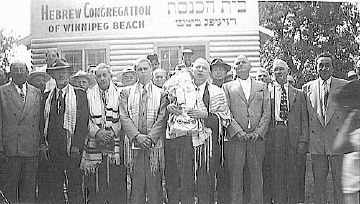
In June 2010 I wrote an article for The Jewish Post & News upon the 60th anniversary of the synagogue’s opening. Here are the opening paragraphs from that article:
“Sixty years ago a group of Winnipeg Beach vacationers decided that what their vacation area lacked was a synagogue. As it happened, a log cabin one-room schoolhouse in the Beausejour area happened to be available.
“In due course, the log cabin was relocated to the corner of Hazel and Grove in Winnipeg Beach, where it stayed for 48 years.”
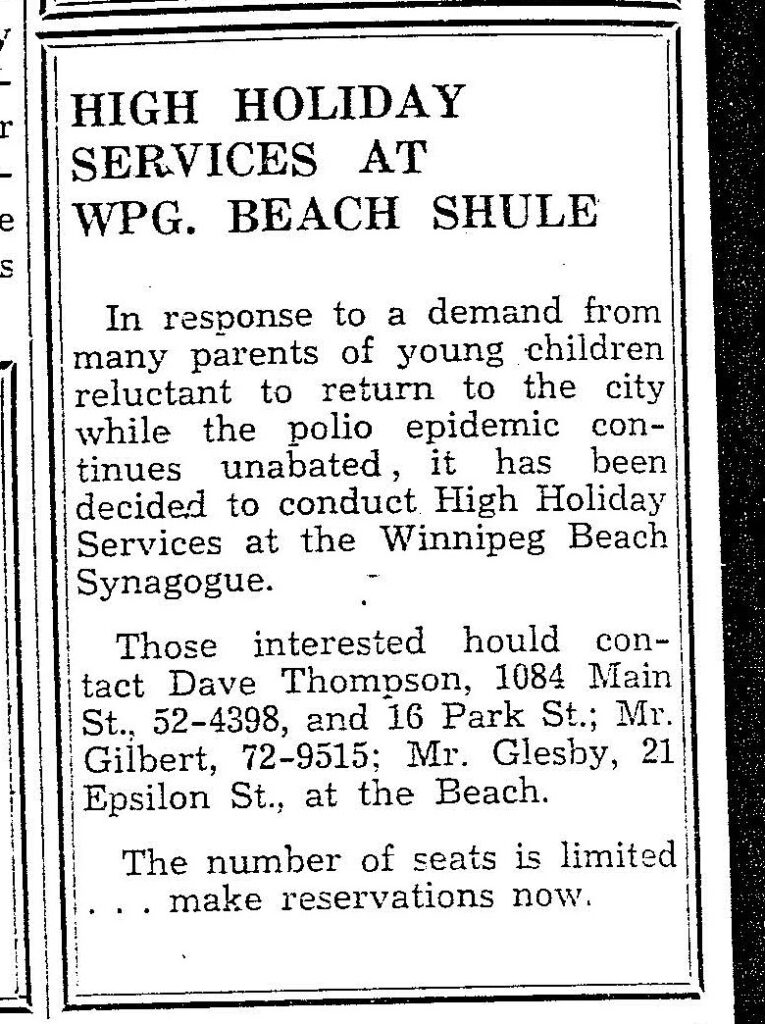
In December 1994 my late brother, Matt, wrote a story about the spraying of antisemitic grafitti on the synagogue which, at that time, was still situated at its original location on the corner of Hazel and Grove in the town of Winnipeg Beach:
“Two 16-year-olds spraypainted slogans like ‘Die Jews,’ ‘I’ll kill you Jews,’ and other grafitti in big letters on the beach synagogue.
“Jim Mosher, a news reporter for the Interlake Spectator in Gimli, said last Halloween’s vandalism against the synagogue wasn’t the first. In the late 1980s, he claimed, it was spraypainted with swastikas.
“Jack Markson, a longtime member of the Winnipeg Beach Synagogue, last week also said he could remember finding anti-Semitic grafitti spraypainted on the synagogue ‘a few years ago,’ and at least twice in the 1970s, when the cottage season was over.”

My 2010 article continued: “In 1998 the Town of Winnipeg Beach informed the members of the synagogue that the building would have to be hooked up to the town’s sewer and water system. Rather than incur the cost of $3-4,000, which was thought to be ‘prohibitive,’ according to longtime beach synagogue attendee Laurie Mainster, synagogue goers looked elsewhere for a solution.
“As a result, the board of Camp Massad was approached and asked whether the synagogue might be relocated there, with the understanding that the synagogue would be made available to the camp at any time other than what were then Friday evening and Saturday morning services.
“Over the years the ‘beach synagogue’ had come to be a very popular meeting place for summertime residents of Winnipeg Beach and Gimli. In fact, for years minyans were held twice daily, in addition to regular Saturday morning services. Of course, in those years Winnipeg Beach was also home to a kosher butcher shop.
“While the little synagogue, which measured only 18 x 24 feet, has gone through several transformations, including the move to Camp Massad, and the opening up to egalitarian services in 2007 (The move to egalitarian services was as much a practical necessity as it was a nod to the equality of women – the only Kohen present at the time was a woman!), it has always remained cramped at the best of times.
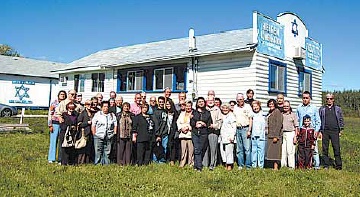
“In recent years the synagogue has seen the addition of a window airconditioner (although to benefit from it, you really have to be sitting just a few feet away), as well as a fridge that allows synagogue attendees to enjoy a regular Saturday morning Kiddush meal following the service.
“According to Laurie Mainster, the Saturday morning service has continued to be popular, even though many of the attendees now drive in from Winnipeg, as they have sold the cottages they once maintained.
“On the other hand, one of the side benefits to being located on Camp Massad’s grounds has been an infusion of young blood from among the camp counsellors.
“Since there is no longer a rabbi available to conduct services (Rabbi Weizman did lead services for years while he had a cottage at the beach), those in attendance now take turns leading the services themselves.
“Anyone may attend services and, while there are no dues collected, donations are welcome. (Donations should be made to the Jewish Foundation of Manitoba, with donors asked to specify that their donations are to be directed to the beach synagogue.)
“Mainster also says that the beach synagogue is now undergoing an expansion, which will be its first in 60 years. An entirely new space measuring 16 x 18 feet is being added – one that will allow for a real Kiddush area. (Until now, a table has been set up in the back of the synagogue and synagogue goers would help themselves to the buffet that is set up each Saturday during the summer. While pleasant enough, it will certainly be more comfortable to have an actual area set aside for the Saturday afternoon after service lunch.)
“As for dress, longtime attendee Abe Borzykowski (in an article written by Sharon Chisvin for the Free Press in 2007) remarked that ‘I don’t think there are many synagogues where people can attend in shorts, T-shirts and sandals and not feel out of place.’ “

As mentioned in that 2010 article, the beach synagogue at that time was about to undergo an extensive remodelling. Here is an article from a January 2011 issue that describes that remodelling process. The article was written by Bernie Sucharov, who has been a longtime member of the beach synagogue:
“The Hebrew Congregation of Winnipeg Beach made a major change to the synagogue this past summer. With the help of many volunteers, Joel Margolese being the project manager, the synagogue was expanded and an addition was built to handle the overflow crowds, as well as to add more space for the kiddush following services.
“The volunteers spent many Sundays during the summer months building the addition. Bad weather caused many delays, but finally the addition was completed one week before the official summer opening.
“The volunteers were: Joel Margolese, Gordon Steindel, Sheldon Koslovsky, Viktor Lewin, Harvey Zabenskie, Nestor Wowryk, Kevin Wowryk, Victor Spigelman, Jerry Pritchard, and David Bloomfield.
“On Sunday, June 25, 2010 a special ceremony was held to affix a mezzuzah to the front entrance door. Gordon Steindel had the honour of affixing the mezzuzah, which was donated by Sid Bercovich and Clarice Silver.
“Refreshments and food for the day were prepared by Phyllis Spigelman, also known as our catering manager. Throughout the summer, Phyllis, Lenore Kagan and other friends prepared the food for our kiddush.
“A sound system was donated by Arch and Brenda Honigman in memory of their father, Sam Honigman z”l. “The system was installed by Joel Margolese and Stevan Sucharov. This will allow the overflow crowd to hear the service in the new addition.
“There were also generous donations of 50 chumashim and an air conditioner. The chumashim were donated by Gwen, Sheldon and Mark Koslovsky. The air conditioner in the new addition was donated by Joel and Linda Margolese.
“The official opening of the synagogue for the summer took place on July 3, 2010. We had an overflow crowd of 70+ people.”
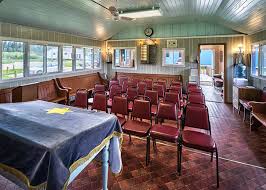
Since that 2010 major addition to the synagogue, it has also added a wheelchair ramp (although I’ve been unable to ascertain exactly when the ramp was built). Also, the synagogue also has its own outdoor privy now. (Attendees used to have to use facilities in Camp Massad.)
And, as already noted in article previously posted to this site (and which you can read at Beach Synagogue about to celebrate 75th anniversary), in recognition of that occasion, on August 2nd members of the synagogue will be holding a 75th anniversary celebration.
As part of the celebration anyone who is a descendant or relative of any of the original members of the first executive committee is invited to attend the synagogue that morning.
If you are a relative please contact Abe Borzykowski at wpgbeachshule@shaw.ca or aborzykowski@shaw.ca to let Abe know you might be attending.
Features
Kinzey Posen: CBC Winnipeg’s former “go-to guy”

By GERRY POSNER If former Winnipegger Lawrence Wall was the CBC go-to guy in Ottawa, CBC Winnipeg had its own version of a go-to guy for many years with none other than the very well known Kinzey Posen. Of course, many readers will recognize that name from his career with Finjan, the Klezmer group so famous across Canada and beyond. It has been written about Posen and his wife Shayla Fink that they have been involved in music since they got out of diapers. And, as an aside, their love and ability in music has now been transmitted to the next generation as in their son, Ariel Posen (but that’s another story).
Kinzey Posen (not to be confused with Posner, or maybe we are to be confused, but who knows for sure?), was a graduate of Peretz School, having attended there from nursery right until Grade 7, graduating in1966. That was followed by Edmund Partridge and West Kildonan Collegiate. Musically, he was in large part self taught. However, he did have some teachers along the way. After moving to Vancouver – from 1974-78, he had the chance to study acoustic classical bass with a member of the Vancouver Symphony Orchestra. When Kinzey lived in Vancouver, he also worked as a jazz musician.
Upon returning to Winnipeg, Kinzey enrolled as a mature student at the University of Winnipeg, where he obtained a Bachelor of Urban Studies degree. Although the degree was in no way connected to the career that followed, his attending the University of Winnipeg was critical to his connecting with the CBC. Why? you ask. Kinzey had a position after graduation working for the Institute of Urban Studies. While there, he met someone who invited him to work for the Department of Continuing Education as one of their program directors. At the time the Department of Continuing Education was located at 491 Portage Avenue, which was also known as the TJ Rice Building. The CBC also leased some space in the same building. According to Kinzey, the CBC part of the building “included HR, different shows and other support offices. Continuing Education was located in the basement and main floor and that’s where I worked.”
KInzey had long had an interest in the CBC, which made the fact that the CBC had some offices in the same building where he was working serendipitous. That Kinzey might be interested in visiting the CBC was not an accident. As a young boy he had a nightly connection to CBC, as it was his ritual to listen to CBC Radio (as well as all sorts of other radio stations across the USA) on his transistor radio every night in bed. He became enamoured of one particular CBC host, Bill Guest, so that when going to sleep, he imagined that he was Guest doing interviews with imaginary guests. That dream of working for CBC became a reality when he had a chance to do a one week gig with Jack Farr’s network program.
Kinzey took a week off from his Continuing Education job and spent five days at the CBC. That week was a training session for Posen, as he had to create ideas, research, pre-interview, write the script, and set up the studio for Farr’s interview. He was almost in his dream job – although not quite – since it was only for one week. His opportunity, however, came in 1988, when he was offered a one-year term as a production assistant – the lowest guy on the ladder, for a show called “ Simply Folk,” with the late Mitch Podolak as the host. Although he was indeed at the bottom as far as those working on the show were concerned, he took a chance and gave his notice to the U of W. The rest is history. In his new job, Kinzey learned how to become a producer. Lucky for him, at the end of the year, when the person he replaced was supposed to come back, she never returned (just like the song, “MTA,” by the Kingston Trio). At that point, Kinzey was hired full time at the CBC.
Kinzey was a fixture at the CBC for 27 years. During those years, Kinzey had the chance to work with Ross Porter, a respected former CBC host and producer, also with Karen Sanders – on the “Afternoon Edition.” One aspect of Kinzey’s job on the Afternoon Edition was to come up with ideas, mix sound effects, arrange interviews and music, to create a two-hour radio experience. In addition, he covered jazz and folk festivals and, as a result, was exposed to some of the best musicians in the world. With Ross Porter in the 1990s, he worked on a network jazz show called “ After Hours,” which was on from 8-10 PM five nights a week. Kinzey was involved with writing the scripts, picking the music, and recording the shows, as well as editing them and then presenting them to the network for playback.
Of course, over his career, Kinzey had many memorable moments. He told me about one of them. The story revolved around the National Jazz Awards one year in particular. The awards were to be broadcasted after the National News which, in those days, began much earlier in the evening, and were over by 8:00 pm. The legendary Oscar Peterson was lined up to play a half hour set at the awards, starting at 7:30. But, as Kinzey told me, Oscar Peterson had a “hate on” for the CBC ecause one of his recorded performances was wrongly edited and he refused to appear on CBC under any circumstances. As the time neared 8:05 PM, which was when the CBC was to begin its broadcast of the jazz awards, it became apparent that Oscar was not going to finish on time. As the producer of the awards show, Kinzey was tasked with telling Oscar Peterson to wrap it up and get off the stage. There was Kinzey Posen, a huge fan of Oscar Peterson, now faced with the prospect of telling Oscar – while he was still playing – with 500 people in the audience, to stop and get off the stage. Not often was or is Kinzey Posen frozen, but that was one such moment. There was one loud “Baruch Hashem” from Kinzey when Oscar completed his set literally just in time.
Clearly, Kinzey was part of a very successful run with After Hours as it was on the air for 14 years. It was easily one of the most popular shows on CBC Radio 2, and a winner of several broadcasting awards. Kinzey also played a major role in producing a two part documentary about legendary guitarist Lenny Breau.
When After Hours ended, Posen became one of the contributing producers to Canada Live and specialized in producing live radio specials for the network, such as the Junos, for CBC Radio One and Two. Needless to say, his career planted Posen in the world of some top notch musicians, including his time spent working with Robert Plant (Led Zeppelin), Dave Brubeck, Randy Bachman, Chantal Kreviazuk and a list of prominent names in the Canadian, American and European music spheres. Locally, the CBC came to refer to Kinzey as the Jewish expert. I would add music expert to that title.
After his 27 year run at the CBC – and before he fully retired, Kinzey went on to work for the Rady JCC as a program director for a year and a half. Of course, to say that Kinzey Posen is retired is a major contradiction in terms. You really can’t keep him down and he has his hand in a variety of programs and projects – most of which he remains silent about, as is his style.
When I realized the full depth and talent of Kinzey Posen, I quickly concluded that he must certainly be related to me. Even if he isn’t, I now tell people he is.
